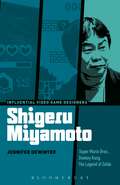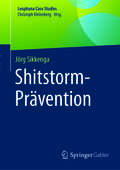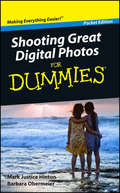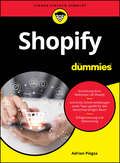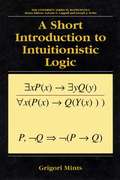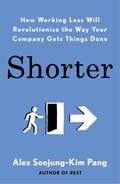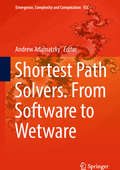- Table View
- List View
Shifting Mobility: Part 1: Transforming Planning and Design for New Human Mobility Code
by Dewan Masud KarimIn the face of resource depletion, environmental changes, lifestyle changes, demographic and digital adaptation, old ideologies of city building and expensive and complex automobility solutions are in freefall. These changes are creating severe friction between the old and new paradigms. This book provides new perspectives through the process of ideological disassociation and concepts of human mobility code. The basic premise of the book, human mobility is an essential component of our creativity that comes from our unconscious desire to become a part of a community. Several new concepts in the book starts with the hallmark of new discovery of human mobility code and its implications of urban mobility boundary systems to stay within safe planetary zone. A new discovery of human mobility code from comprehensive research finding prove that each individual develops a unique mobility footprint and become our mobility identity. Beyond individual hallmarks, human develops collective mobility codes through interaction with the third space on which entire mobility systems lie and are created by the fundamentals of city planning and the design process. Readers are introduced to an innovative mobility planning process and reinvention of multimodal mobility approaches based on new mobility code while formulating new concepts, practical solutions and implementation techniques, tools, policies, and processes to reinforce low-carbon mobility options while addressing social equity, environmental, and health benefits. Finally, the book arms us with knowledge to prevent the disaster of full technological enlightenment against our natural human mobility code.
Shifting Paradigms in Software Engineering: Proceedings of the 7th Joint Conference of the Austrian Computer Society (OCG) and the John von Neumann Society for Computing Sciences (NJSZT) in Klagenfurt, Austria, 1992
by Roland MittermeirObject-orientation and the need for multi-paradigmatic systems constitute a challenge for researchers, practitioners and instructors. Presentations at the OCG/NJSZT joint conference in Klagenfurt, Austria, in September 1992 addressed these issues. The proceedings comprise such topics as: project management, artificial intelligence - modelling aspects, artificial intelligence - tool building aspects, language features, object-orientied software development, the challenge of coping with complexity, methodology, and experience, software engineering education, science policy, etc.
Shigeru Miyamoto: Super Mario Bros., Donkey Kong, The Legend of Zelda (Influential Video Game Designers)
by Jennifer DeWinterVideo games are considered by many to be just entertainment-essentially void of skillful, artistic intervention. But as any gamer knows, there's incredible technical and graphic talent behind even a flickering Gameboy screen.You may have never heard Shigeru Miyamoto's name, but you've probably spent many a lazy afternoon absorbed in his work. Joining Nintendo as a video game designer in the late 1970s, Miyamoto created the powerhouse franchises Super Mario Bros., The Legend of Zelda, and Donkey Kong-games so ubiquitous that Miyamoto was named one of TIME's 100 Most Influential People in 2007. Combining critical essays with interviews, bibliographies, and striking visuals, Shigeru Miyamoto unveils the artist behind thousands of glowing gaming screens, tracing out his design decisions, aesthetic preferences, and the material conditions that shaped his work. With this incredible (and incredibly unknown) figure, series editors Jennifer DeWinter and Carly Kocurek launch the Influential Video Game Designers series, at last giving these artists the recognition they deserve.
Shigeru Miyamoto: Super Mario Bros., Donkey Kong, The Legend of Zelda (Influential Video Game Designers)
by Jennifer DeWinterVideo games are considered by many to be just entertainment-essentially void of skillful, artistic intervention. But as any gamer knows, there's incredible technical and graphic talent behind even a flickering Gameboy screen.You may have never heard Shigeru Miyamoto's name, but you've probably spent many a lazy afternoon absorbed in his work. Joining Nintendo as a video game designer in the late 1970s, Miyamoto created the powerhouse franchises Super Mario Bros., The Legend of Zelda, and Donkey Kong-games so ubiquitous that Miyamoto was named one of TIME's 100 Most Influential People in 2007. Combining critical essays with interviews, bibliographies, and striking visuals, Shigeru Miyamoto unveils the artist behind thousands of glowing gaming screens, tracing out his design decisions, aesthetic preferences, and the material conditions that shaped his work. With this incredible (and incredibly unknown) figure, series editors Jennifer DeWinter and Carly Kocurek launch the Influential Video Game Designers series, at last giving these artists the recognition they deserve.
Shitstorm-Prävention
by Jörg SikkengaDas Buch stellt die Gefahr von Shitstorms dar, die schnell in Sozialen Medien aufziehen und Unternehmen schaden können. Die Sozialen Medien oder das Web 2.0 stellen eine besondere Herausforderung für das Marketing dar, da die Konsumentinnen und Konsumenten Rückmeldung zu den gekauften Produkten geben und damit reale sowie vermeintliche Missstände anprangern können. Darauf muss die Unternehmenskommunikation reagieren. Für Unternehmen wäre es ein Worst-Case-Szenario, wenn ein Shitstorm seinen Ruf nachhaltig schädigt und intensive Marketingbemühungen verpuffen lassen würde. Die Case Study behandelt das Thema Shitstorm-Attacken auf zwei Ebenen. So diskutiert sie auf der ersten Ebene die Möglichkeiten der Shitstorm-Prävention des Unternehmens, aus denen dann eine Präventionsstrategie erarbeitet wird. Auf der zweiten Ebene wird anhand eines Beispiels ein Plan entwickelt, mit dem ein Shitstorm beruhigt werden kann. Beide Strategien können von Unternehmen eingesetzt werden, um sowohl Shitstorms vorzubeugen als auch diese frühzeitig zu minimieren.Die Leuphana Case Studies sind ein Projekt, das in Zusammenarbeit mit kleinen und mittelständischen Unternehmen erstellt und entwickelt worden ist. Sie sind ein Lehrbuch, mit dessen Hilfe Unternehmen, die vor ähnlichen Herausforderungen stehen, selbige bewältigen können. Dafür ist keine Hilfe von Dritten notwendig. Auf Grundlage der einzelnen Case Studies werden den Bearbeiterinnen und Bearbeitern elementare Werkzeuge aus der wissenschaftlichen Theorie erklärt. Diese können sie anwenden, um mit den Insiderkenntnissen des eigenen Unternehmens Prozesse zu optimieren, Ziele entwickeln und erreichen oder schwierige Herausforderungen zu bewältigen.
Shock and Damage Models in Reliability Theory (Springer Series in Reliability Engineering)
by Toshio NakagawaThis is the first monograph which presents shock and damage models in reliability from introduction to application. Stochastic processes are introduced before current developments are surveyed. The practical applications of shock and damage models are demonstrated using case studies. The author is a leading researcher in this field with more than thirty years of experience. Reliability engineers and managers of maintenance work will find this book a broad reference.
Shock, Impact and Explosion: Structural Analysis and Design
by M.Y.H. BangashTable F.1. Reinforcement for one and two way elements Pressure Reinforcement Two-way One-way design range elements elements Intermediate Main A =0.0025bd A =0.0025bd s s and low Other A =0.0018bd A +A =0.0020bT s s c s High Main A = A A = A s s s s =0.0025bd =0.0025bd c c Other A = A A = A s s s s a a =0.0018bd =0.0018bd c c a But not less than A /4 used in the main direction (see Fig. F.2 for coe?cients) s where A = area of compression reinforcement within the width b, d = s distancefromtheextremecompression?bretothecentroidofcompression reinforcement, a = depth of the equivalent rectangular stress block = (A ?A )f /0.85bf . s s s c The minimum area of ?exural reinforcement is given in Table F.1. Ultimate Static Shear Capacity Diagonal Tension (1) Theultimateshearstressv ,asameasureofdiagonaltension,iscomputed u for type I sections from v = V /bd (F.5) u u and for type II and III sections from v = V /bd , (F.6) u u c whereV isthetotalshearona widthbatthesectiona distanced(type I) u or d (type II and III) from the face of the support. The shear at sections c between the face of the support and the section d or d therefrom need c not be considered critical. (2) The shear stress permitted on an unreinforced web is limited to ? ?
Shoot Sexy: Pinup Photography in the Digital Age
by Ryan ArmbrustThe pinup look made famous on WWII bombers and in the 1950s has become a timeless classic that is now undergoing a revival through digital photography. Alongside the rapid growth of the Boudoir genre - also covered in this book - the retro pinup look is an increasingly popular request from clients. This book will show you all how to achieve it, whether you're shooting professionally, or just for fun.
Shooting Great Digital Photos For Dummies, Pocket Edition
by Mark Justice Hinton Barbara ObermeierMake your photos better than ever with these great tips! Photography is fun, and thebetter your photos, the morefun you'll have. This little bookis packed with advice to help you set up super shots, make the most of lighting, explore exposure, and sharpen your focus. Learn to take advantage of your camera's settings, and watch your confidence grow as your images improve. Open the book and find: Creative ways to play with lighting All about getting close-up shots How to focus on a moving target Composition tips Things you should know when using manual mode
Shopify Application Development
by Michael LarkinThis is an easy-to follow manual that will guide you through the entire process of application development with Shopify, beginning with the installation and configuration of your local development environment for your app to the deployment of the app to Heroku. If you are a web developer or a designer who wants to extend Shopify stores by building apps, then this book is for you. A basic understanding of programming concepts and some familiarity with Shopify is all that is required to get started with Shopify app development.
Shopify für Dummies (Für Dummies)
by Adrian PiegsaIn kürzester Zeit erfolgreich auf Shopify Mit Shopify bauen Sie Ihren eigenen Online-Shop, der perfekt zu Ihren Bedürfnissen passt. Adrian Piegsa gibt Ihnen einen Überblick über die Shop-Plattform, zeigt Ihnen, wie Sie sich zurechtfinden und worauf Sie achten müssen. Sie lernen Schritt für Schritt, wie Sie Ihren Webshop mit Kategorien und Produkten anlegen, Bestellungen abwickeln und Ihren Erfolg optimieren. Darüber hinaus erfahren Sie alles über Vertriebs- und Werbemöglichkeiten von Shopify und erhalten Tipps und Tricks im Umgang mit der Software ? speziell für den deutschsprachigen Raum. Sie erfahren Wie Sie sich auf Shopify zurechtfinden Was eine gute Shop-Struktur ausmacht Wie Sie Shopify-Apps sinnvoll nutzen Wie Sie Ihre Statistiken einsehen und auswerten
A Short Course in Computational Geometry and Topology (SpringerBriefs in Applied Sciences and Technology)
by Herbert EdelsbrunnerThis monograph presents a short course in computational geometry and topology. In the first part the book covers Voronoi diagrams and Delaunay triangulations, then it presents the theory of alpha complexes which play a crucial role in biology. The central part of the book is the homology theory and their computation, including the theory of persistence which is indispensable for applications, e.g. shape reconstruction. The target audience comprises researchers and practitioners in mathematics, biology, neuroscience and computer science, but the book may also be beneficial to graduate students of these fields.
A Short Course in Quantum Information Theory: An Approach From Theoretical Physics (Lecture Notes in Physics #827)
by Lajos DiosiThis short and concise primer takes the vantage point of theoretical physics and the unity of physics. It sets out to strip the burgeoning field of quantum information science to its basics by linking it to universal concepts in physics. An extensive lecture rather than a comprehensive textbook, this volume is based on courses delivered over several years to advanced undergraduate and beginning graduate students, but essentially it addresses anyone with a working knowledge of basic quantum physics. Readers will find these lectures a most adequate entry point for theoretical studies in this field. For the second edition, the authors has succeeded in adding many new topics while sticking to the conciseness of the overall approach. A new chapter on qubit thermodynamics has been added, while new sections and subsections have been incorporated in various chapter to deal with weak and time-continuous measurements, period-finding quantum algorithms and quantum error corrections. From the reviews of the first edition: "The best things about this book are its brevity and clarity. In around 100 pages it provides a tutorial introduction to quantum information theory, including problems and solutions. … it’s worth a look if you want to quickly get up to speed with the language and central concepts of quantum information theory, including the background classical information theory." (Craig Savage, Australian Physics, Vol. 44 (2), 2007)
A Short Course in Quantum Information Theory: An Approach From Theoretical Physics (Lecture Notes in Physics #713)
by Lajos DiosiThis concise primer combines the twin vantage points of theoretical physics and the unity of physics. It strips quantum information science to its basics by linking it to universal concepts in physics. Designed as an extensive lecture rather than a textbook, the book is based on courses delivered over several years to advanced undergraduate and beginning graduate students, and addresses anyone with a working knowledge of basic quantum physics.
A Short Course on Error Correcting Codes (CISM International Centre for Mechanical Sciences #188)
by N.J.A. SloaneA Short Introduction to Intuitionistic Logic (University Series in Mathematics)
by Grigori MintsIntuitionistic logic is presented here as part of familiar classical logic which allows mechanical extraction of programs from proofs. to make the material more accessible, basic techniques are presented first for propositional logic; Part II contains extensions to predicate logic. This material provides an introduction and a safe background for reading research literature in logic and computer science as well as advanced monographs. Readers are assumed to be familiar with basic notions of first order logic. One device for making this book short was inventing new proofs of several theorems. The presentation is based on natural deduction. The topics include programming interpretation of intuitionistic logic by simply typed lambda-calculus (Curry-Howard isomorphism), negative translation of classical into intuitionistic logic, normalization of natural deductions, applications to category theory, Kripke models, algebraic and topological semantics, proof-search methods, interpolation theorem. The text developed from materal for several courses taught at Stanford University in 1992-1999.
A Short Introduction to Preferences: Between AI and Social Choice (Synthesis Lectures on Artificial Intelligence and Machine Learning)
by Francesca Bellet Kristen Brent HabrardComputational social choice is an expanding field that merges classical topics like economics and voting theory with more modern topics like artificial intelligence, multiagent systems, and computational complexity. This book provides a concise introduction to the main research lines in this field, covering aspects such as preference modelling, uncertainty reasoning, social choice, stable matching, and computational aspects of preference aggregation and manipulation. The book is centered around the notion of preference reasoning, both in the single-agent and the multi-agent setting. It presents the main approaches to modeling and reasoning with preferences, with particular attention to two popular and powerful formalisms, soft constraints and CP-nets. The authors consider preference elicitation and various forms of uncertainty in soft constraints. They review the most relevant results in voting, with special attention to computational social choice. Finally, the book considers preferences in matching problems. The book is intended for students and researchers who may be interested in an introduction to preference reasoning and multi-agent preference aggregation, and who want to know the basic notions and results in computational social choice. Table of Contents: Introduction / Preference Modeling and Reasoning / Uncertainty in Preference Reasoning / Aggregating Preferences / Stable Marriage Problems
Short Sims: A Game Changer
by Clark AldrichShort Sims: A Game Changer explores the design concepts, dialogue, and formatting of interactive simulations. Interactivity is the key to effective educational media in schools, corporations, the military, and government. However, challenges like ineffective linear content or expenses can derail the product. This book provides a proven methodology to guide anyone through the steps of quickly creating highly engaging and responsive content. The process combines decades of research and implementations with leading organizations (Bill & Melinda Gates Foundation, Harvard Business School Publishing, Visa, State Department) with new tools that have just emerged. Key Features This book provides numerous code examples to illustrate how to put the techniques into practice. It includes expanded introductions to mathematics fundamental to computer graphics and game development. Graphics and physics are covered in introductory overviews. Author Bio Clark Aldrich is an education technology thought leader—the author of six books and developer of patent and award-winning projects. He currently builds custom Short Sims for organizations using a revolutionary methodology he has pioneered, or helps them build their own, through www.shortsims.com. He is also the host of an audio series called Education X Media (www.edbymedia.com) about evolving pedagogy in academics, corporations, and the military. He has been called a "guru" by Fortune Magazine and a "maverick" by CNN. Aldrich and his work have been featured in hundreds of other sources, including CBS, ABC, The New York Times, USA Today, the Associated Press, Wall Street Journal, NPR, CNET, Business 2.0, BusinessWeek, and U.S. News and World Report. He has written monthly columns for Training Magazine and Online Learning Magazine. Previously, he was the founder and former director of research for Gartner’s e-learning coverage. Earlier in his career, he worked on special projects for Xerox' executive team. He also served for many years as the Governor's representative on the education task force Joint Committee on Educational Technology, volunteered on several non-profit organizations aimed at child advocacy, and has served on numerous boards. He earned from Brown University a degree in cognitive science (during which he also taught at a leading environmental education foundation). He grew up in Concord, Massachusetts, and is the ninth great-grandson of Governors John Winthrop and Thomas Dudley, first and second governors of the Massachusetts Bay Colony, and Captain Walter Neale, the first colonial governor of lower New Hampshire.
Short Sims: A Game Changer
by Clark AldrichShort Sims: A Game Changer explores the design concepts, dialogue, and formatting of interactive simulations. Interactivity is the key to effective educational media in schools, corporations, the military, and government. However, challenges like ineffective linear content or expenses can derail the product. This book provides a proven methodology to guide anyone through the steps of quickly creating highly engaging and responsive content. The process combines decades of research and implementations with leading organizations (Bill & Melinda Gates Foundation, Harvard Business School Publishing, Visa, State Department) with new tools that have just emerged. Key Features This book provides numerous code examples to illustrate how to put the techniques into practice. It includes expanded introductions to mathematics fundamental to computer graphics and game development. Graphics and physics are covered in introductory overviews. Author Bio Clark Aldrich is an education technology thought leader—the author of six books and developer of patent and award-winning projects. He currently builds custom Short Sims for organizations using a revolutionary methodology he has pioneered, or helps them build their own, through www.shortsims.com. He is also the host of an audio series called Education X Media (www.edbymedia.com) about evolving pedagogy in academics, corporations, and the military. He has been called a "guru" by Fortune Magazine and a "maverick" by CNN. Aldrich and his work have been featured in hundreds of other sources, including CBS, ABC, The New York Times, USA Today, the Associated Press, Wall Street Journal, NPR, CNET, Business 2.0, BusinessWeek, and U.S. News and World Report. He has written monthly columns for Training Magazine and Online Learning Magazine. Previously, he was the founder and former director of research for Gartner’s e-learning coverage. Earlier in his career, he worked on special projects for Xerox' executive team. He also served for many years as the Governor's representative on the education task force Joint Committee on Educational Technology, volunteered on several non-profit organizations aimed at child advocacy, and has served on numerous boards. He earned from Brown University a degree in cognitive science (during which he also taught at a leading environmental education foundation). He grew up in Concord, Massachusetts, and is the ninth great-grandson of Governors John Winthrop and Thomas Dudley, first and second governors of the Massachusetts Bay Colony, and Captain Walter Neale, the first colonial governor of lower New Hampshire.
The Shortcut: Why Intelligent Machines Do Not Think Like Us
by Nello CristianiniAn influential scientist in the field of artificial intelligence (AI) explains its fundamental concepts and how it is changing culture and society. A particular form of AI is now embedded in our tech, our infrastructure, and our lives. How did it get there? Where and why should we be concerned? And what should we do now? The Shortcut: Why Intelligent Machines Do Not Think Like Us provides an accessible yet probing exposure of AI in its prevalent form today, proposing a new narrative to connect and make sense of events that have happened in the recent tumultuous past, and enabling us to think soberly about the road ahead. This book is divided into ten carefully crafted and easily digestible chapters. Each chapter grapples with an important question for AI. Ranging from the scientific concepts that underpin the technology to wider implications for society, it develops a unified description using tools from different disciplines and avoiding unnecessary abstractions or words that end with -ism. The book uses real examples wherever possible, introducing the reader to the people who have created some of these technologies and to ideas shaping modern society that originate from the technical side of AI. It contains important practical advice about how we should approach AI in the future without promoting exaggerated hypes or fears. Entertaining and disturbing but always thoughtful, The Shortcut confronts the hidden logic of AI while preserving a space for human dignity. It is essential reading for anyone with an interest in AI, the history of technology, and the history of ideas. General readers will come away much more informed about how AI really works today and what we should do next.
The Shortcut: Why Intelligent Machines Do Not Think Like Us
by Nello CristianiniAn influential scientist in the field of artificial intelligence (AI) explains its fundamental concepts and how it is changing culture and society. A particular form of AI is now embedded in our tech, our infrastructure, and our lives. How did it get there? Where and why should we be concerned? And what should we do now? The Shortcut: Why Intelligent Machines Do Not Think Like Us provides an accessible yet probing exposure of AI in its prevalent form today, proposing a new narrative to connect and make sense of events that have happened in the recent tumultuous past, and enabling us to think soberly about the road ahead. This book is divided into ten carefully crafted and easily digestible chapters. Each chapter grapples with an important question for AI. Ranging from the scientific concepts that underpin the technology to wider implications for society, it develops a unified description using tools from different disciplines and avoiding unnecessary abstractions or words that end with -ism. The book uses real examples wherever possible, introducing the reader to the people who have created some of these technologies and to ideas shaping modern society that originate from the technical side of AI. It contains important practical advice about how we should approach AI in the future without promoting exaggerated hypes or fears. Entertaining and disturbing but always thoughtful, The Shortcut confronts the hidden logic of AI while preserving a space for human dignity. It is essential reading for anyone with an interest in AI, the history of technology, and the history of ideas. General readers will come away much more informed about how AI really works today and what we should do next.
A Shortcut Through Time: The Path to A Quantum Computer
by George JohnsonThe newest Pentium chip powering PCs and laptops contains 40 million electronic switches packed onto a piece of silicon about the size of a thumbnail. Several years from now, if this incredible shrinking continues, a single chip will hold a billion switches, then a trillion. The logical culmination is a computer in which the switches are so tiny that each consists of an individual atom. At that point something miraculous happens: quantum mechanics kick in. Anyone who follows the science news or watches 'Star Trek' has at least a notion of what that means: particles can be in two or more places at once. Atoms obey a peculiar logic of their own - and if it can be harnessed society will be transformed. Problems that would now take forever would be solved almost instantly. Quantum computing promises nothing less than a shortcut through time.
Shorter: How Working Less Will Revolutionise the Way Your Company Gets Things Done
by Alex Soojung-Kim PangForget the old concept of the 9-5. Companies around the world are redesigning the work week to increase efficiency, health and happiness in their workers.A growing number of businesses are shortening their working week to address problems with low productivity, poor mental health and unequal working opportunities. Workers are still paid the same salary for a four-day week and the results are revolutionary. In Shorter, bestselling author Alex Pang studies these trailblazing businesses where managers are reporting their teams to be:- More creative in their problem solving- Happier and with lower stress, anxiety and cases of burn out- More productive Pang will reveal step by step, how they have gone about making these changes, the challenges and solutions and, most importantly, how you can do the same.
The Shortest-Path Problem: Analysis and Comparison of Methods (Synthesis Lectures on Theoretical Computer Science)
by Hector Ortega-Arranz Arturo Gonzalez-Escribano Diego R. LlanosMany applications in different domains need to calculate the shortest-path between two points in a graph. In this paper we describe this shortest path problem in detail, starting with the classic Dijkstra's algorithm and moving to more advanced solutions that are currently applied to road network routing, including the use of heuristics and precomputation techniques. Since several of these improvements involve subtle changes to the search space, it may be difficult to appreciate their benefits in terms of time or space requirements. To make methods more comprehensive and to facilitate their comparison, this book presents a single case study that serves as a common benchmark. The paper also compares the search spaces explored by the methods described, both from a quantitative and qualitative point of view, and including an analysis of the number of reached and settled nodes by different methods for a particular topology. Table of Contents: List of Figures / List of Tables / Acknowledgments / Introduction / Graph Theory Basics / Classical Algorithms / Hierarchical Preprocessing-Dependent Approaches / Non-Hierarchical Preprocessing-Dependent Approaches / Analysis and Comparison of Approaches / Conclusions / Bibliography / Authors' Biographies
Shortest Path Solvers. From Software to Wetware (Emergence, Complexity and Computation #32)
by Andrew AdamatzkyThis book offers advanced parallel and distributed algorithms and experimental laboratory prototypes of unconventional shortest path solvers. In addition, it presents novel and unique algorithms of solving shortest problems in massively parallel cellular automaton machines. The shortest path problem is a fundamental and classical problem in graph theory and computer science and is frequently applied in the contexts of transport and logistics, telecommunication networks, virtual reality and gaming, geometry, and social networks analysis. Software implementations include distance-vector algorithms for distributed path computation in dynamics networks, parallel solutions of the constrained shortest path problem, and application of the shortest path solutions in gathering robotic swarms. Massively parallel algorithms utilise cellular automata, where a shortest path is computed either via matrix multiplication in automaton arrays, or via the representation of data graphs in automaton lattices and using the propagation of wave-like patterns. Unconventional shortest path solvers are presented in computer models of foraging behaviour and protoplasmic network optimisation by the slime mould Physarum polycephalum and fluidic devices, while experimental laboratory prototypes of path solvers using chemical media, flows and droplets, and electrical current are also highlighted. The book will be a pleasure to explore for readers from all walks of life, from undergraduate students to university professors, from mathematicians, computers scientists and engineers to chemists and biologists.


